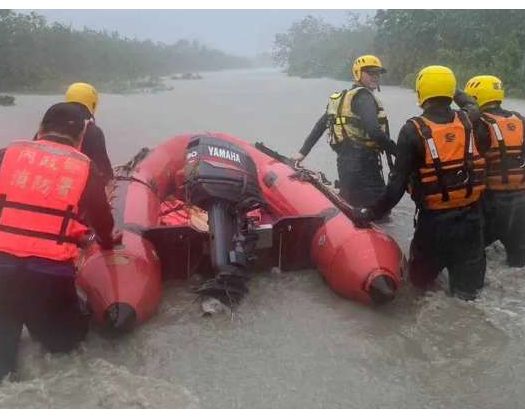Taipei - The Central Emergency Operation Center of Taiwan reported on Thursday that a cargo vessel had met its demise after Typhoon Gaemi traversed over the nation during the overnight hours.
The freighter, named Fu-Shun and bearing the Tanzanian flag, met its unfortunate fate off the coast of Kaohsiung, with nine members of the crew originating from Myanmar remaining missing. The ensuing search operation is slated to commence once conditions are deemed safe enough.
Typhoon Gaemi made its entrance on the island on the latter part of Wednesday evening, making its mark on the eastern region of Yilan County around midnight (local time; 1600 GMT Wednesday). Subsequently, the cyclone moved into the Taiwan Strait early on Thursday morning, as confirmed by the Central Weather Administration.
Although the typhoon's intensity has diminished, authorities have cautioned residents in the southern and central regions of Taiwan about the potential for flooding in the days ahead.
As of the morning hours of Thursday, approximately 87,000 households were subjected to power outages, with educational institutions, workplaces, and financial hubs remaining inaccessible for a continuation of the previous day.
The severe storm brought with it formidable winds and heavy precipitation, claiming two lives according to the disaster management center. These fatalities were attributed to a tree falling on a person and a building collapsing onto a vehicle, respectively. Additionally, there were reports of 279 injuries.
Armed with around 29,000 military personnel on standby, President Lai Ching-te emphasized the importance of prioritizing safety during a morning emergency briefing on Wednesday.
President Lai also stressed the critical nature of the ensuing 24 hours, acknowledging the significant challenges faced by emergency services and their personnel in mitigating the impact of the storm.
Prior to its arrival, Typhoon Gaemi was the inaugural typhoon of the season to confront Taiwan, boasting wind speeds of up to 190 kilometers per hour (118 miles per hour). It is anticipated to deliver a minimum of 1,800 millimeters or 70 inches of rainfall across southern and central Taiwan.
The storm has already affected Japan and the Philippines, thereby augmenting the seasonal monsoon rains in Manila. This resulted in a series of landslides and flooding over a span of five days, with reported fatalities of at least eight individuals, as per Philippine authorities.
Upon crossing the Taiwan Strait, Typhoon Gaemi is set to strike the southeastern coast of the Chinese province of Fujian in the late afternoon of Thursday.
"This is expected to be one of the most intense typhoons in recent memory," remarked fishing boat captain Hung Chun to Reuters news agency. "Its trajectory is straight for the eastern coast, and the damage potential is staggering."
The government has arranged evacuations for over 4,000 residents from mountainous areas susceptible to landslides due to torrential rainfall. Additionally, approximately 400 flights have been canceled, and railway services have ceased operations since midday. Nonetheless, select train services between the north and south regions of Taiwan will continue operations.
However, Taiwan Semiconductor Manufacturing Company (TSMC), recognized globally as the leading manufacturer of chips, has indicated that its operations will proceed as scheduled. The company has, however, initiated precautionary measures in response to the situation.
Beijing, which asserts sovereignty over Taiwan, has announced plans to temporarily cease all passenger train services in the Fujian province on Thursday and on some days later, due to the inclement weather conditions.
Regulatory bodies have reported that the capital could experience up to 150 millimeters (six inches) of rainfall within a span of 24 hours, extending from Wednesday evening into Thursday.
In light of these safety concerns, certain tourist attractions have been declared off-limits for the duration of the storm. Additionally, mountain and riverside hostels have been required to close temporarily.
In a proactive measure to ensure public safety, Beijing's residents have been directed to limit outdoor engagements, avoid areas prone to flooding, such as hills and riversides, and to be vigilant in locating safe shelters.
Furthermore, authorities in the adjacent Hebei province, which encompasses Beijing and sustains a population of over 70 million individuals, have issued warnings regarding potential flooding, as reported by the state news agency Xinhua.













